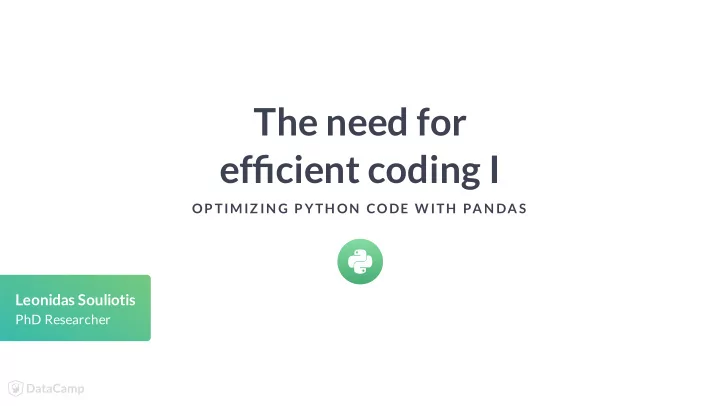

The need for ef�cient coding I OP TIMIZ IN G P YTH ON CODE W ITH PAN DAS Leonidas Souliotis PhD Researcher
How do we measure time? time.time() : returns current time in seconds since 12:00am, January 1, 1970 import time # record time before execution start_time = time.time() # execute operation result = 5 + 2 # record time after execution end_time = time.time() print("Result calculated in {} sec".format(end_time - start_time)) Result calculated in 9.48905944824e-05 sec OPTIMIZING PYTHON CODE WITH PANDAS
For loop vs List comprehension List comprehension: list_comp_start_time = time.time() result = [i*i for i in range(0,1000000)] list_comp_end_time = time.time() print("Time using the list_comprehension: {} sec".format(list_comp_end_time - list_comp_start_time)) For loop: for_loop_start_time= time.time() result=[] for i in range(0,1000000): result.append(i*i) for_loop_end_time= time.time() print("Time using the for loop: {} sec".format(for_loop_end_time - for_loop_start_time)) OPTIMIZING PYTHON CODE WITH PANDAS
For loop vs List comprehension II Time using the list comprehension: 0.11042404174804688 sec Time using the for loop: 0.2071230411529541 sec list_comp_time = list_comp_end_time - list_comp_start_time for_loop_time = for_loop_end_time - for_loop_start_time print("Difference in time: {} %".format((for_loop_time - list_comp_time)/ list_comp_time*100)) Difference in time: 87.55527367398622 % OPTIMIZING PYTHON CODE WITH PANDAS
Where time matters I Calculate 1 + 2 + ... + 1000000 . Adding numbers one by one: def sum_brute_force(N): res = 0 for i in range(1,N+1): res+=i return res N ⋅ ( N + 1) Using 1 + 2 + ... + N = 2 def sum_formula(N): return N*(N+1)/2 OPTIMIZING PYTHON CODE WITH PANDAS
Where time matters II Using the formula: Using brute force: # Using the formula # Using brute force formula_start_time = time.time() bf_start_time = time.time() formula_result = formula(1000000) bf_result = sum_brute_force(1000000) formula_end_time = time.time() bf_end_time = time.time() print("Time using the formula: {} print("Time using brute force: {} sec".format(formula_end_time - formula_start_time sec".format(bf_end_time - start_time)) Using the formula: 0.000108957290649 sec Time using brute force: 0.174870967865 sec Difference in speed: 160,394.967179% OPTIMIZING PYTHON CODE WITH PANDAS
Let's do it! OP TIMIZ IN G P YTH ON CODE W ITH PAN DAS
Locate rows: .iloc[] and .loc[] OP TIMIZ IN G P YTH ON CODE W ITH PAN DAS Leonidas Souliotis PhD Candidate
The poker dataset S1 R1 S2 R2 S3 R3 S4 R4 S5 R5 1 ♦ 10 Jack King 4 Ace ♣ ♣ ♠ ♥ 2 ♦ Jack King 10 Queen Ace ♦ ♦ ♦ ♦ 3 ♣ Queen Jack King 10 Ace ♣ ♣ ♣ ♣ Sn : symbol of the n-th card S1 R1 S2 R2 S3 R3 S4 R4 S5 R5 1 — Hearts, 2 — Diamonds, 3 — Clubs, 4 — Spades 1 2 10 3 11 3 13 4 4 1 1 Rn : rank of the n-th card 2 2 11 2 13 2 10 2 12 2 1 3 3 12 3 11 3 13 3 10 3 1 1 — Ace, 2-10, 11 — Jack, 12 — Queen, 13 — King OPTIMIZING PYTHON CODE WITH PANDAS
Locate targeted rows .loc[] — index name locator .iloc[] — index number locator # Specify the range of rows to select # Specify the range of rows to select rows = range(0, 500) rows = range(0, 500) # Time selecting rows using .loc[] # Time selecting rows using .iloc[] loc_start_time = time.time() iloc_start_time = time.time() data.loc[rows] data.iloc[rows] loc_end_time = time.time() iloc_end_time = time.time() print("Time using .loc[] : {} sec".format( print("Time using .iloc[]: {} sec".format( loc_end_time - loc_start_time)) iloc_end_time - iloc_start_time) Time using .loc[]: 0.001951932 seconds Time using .iloc[] : 0.0007140636 sec Difference in speed: 173.355592654% OPTIMIZING PYTHON CODE WITH PANDAS
Locate targeted columns .iloc[] — index number locator Locating columns by names iloc_start_time = time.time() names_start_time = time.time() data.iloc[:,:3] data[['S1', 'R1', 'S2']] iloc_end_time = time.time() names_end_time = time.time() print("Time using .iloc[]: {} sec".format( print("Time using selection by name: {} sec".form iloc_end_time - iloc_start_time)) names_end_time - names_start_time)) Time using .iloc[]: 0.00125193595886 sec Time using selection by name: 0.000964879989624 s Difference in speed: 29.7504324188% OPTIMIZING PYTHON CODE WITH PANDAS
Let's do it! OP TIMIZ IN G P YTH ON CODE W ITH PAN DAS
Select random rows OP TIMIZ IN G P YTH ON CODE W ITH PAN DAS Leonidas Souliotis PhD Candidate
Sampling random rows using pandas start_time = time.time() poker.sample(100, axis=0) print("Time using sample: {} sec".format(time.time() - start_time)) Time using sample: 0.000750064849854 sec OPTIMIZING PYTHON CODE WITH PANDAS
Sampling random rows using numpy start_time = time.time() poker.iloc[np.random.randint(low=0, high=poker.shape[0], size=100)] print("Time using .iloc[]: {} sec".format(time.time() - start_time)) Time using .iloc[]: 0.00103211402893 sec Difference in speed: 37.6033057849% OPTIMIZING PYTHON CODE WITH PANDAS
Sampling random columns start_time = time.time() poker.sample(3, axis=1) print("Time using .sample(): {} sec".format(time.time() - start_time)) Time using .sample(): 0.000683069229126 sec N = poker.shape[1] start_time = time.time() poker.iloc[:,np.random.randint(low=0, high=N, size=3)] print("Time using .iloc[]: {} sec".format(time.time() - start_time)) ime using .iloc[]: 0.0010929107666 sec Difference in speed: 59.9999999998% OPTIMIZING PYTHON CODE WITH PANDAS
Let's do it! OP TIMIZ IN G P YTH ON CODE W ITH PAN DAS
Recommend
More recommend